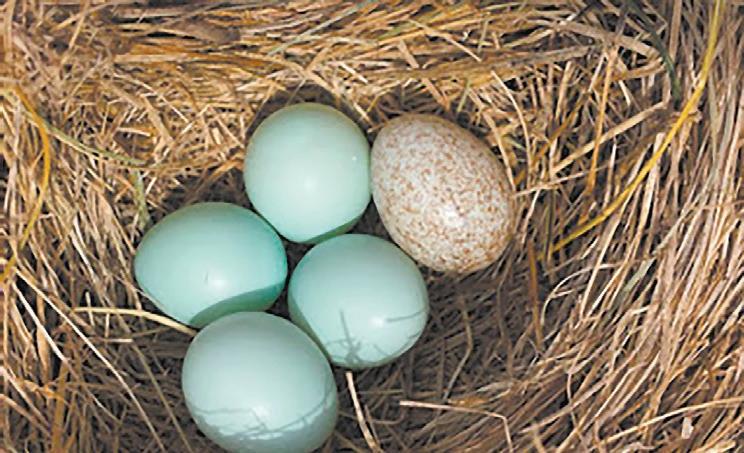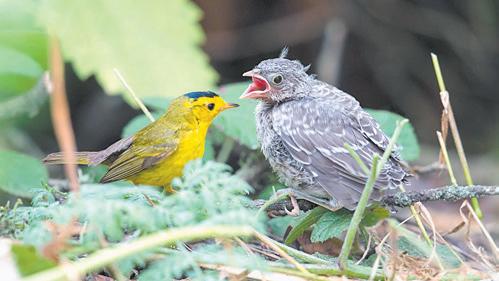
5 minute read
OWLS: Who’s Your Daddy, Cowbird?
Surprise! Cowbirds don’t build their own nests. Instead, they remove an egg from another species’ nest, replace it with one of their own and then rely on the surrogate parent to incubate the egg and rear the nestling. Wow, how lazy can one bird be? Or is that smart? Naturalists speculate that because of the Cowbird’s nomadic lifestyle (accompanying grazing herds of bison or cattle), they stray too far from home to reach a nest in time to deposit an egg, so they evolved to rely on another bird’s nest. They aren’t very particular when scouting for a nest to deposit an egg either, although they are said to prefer “cup-shaped” regardless of species.
Cowbirds are the most common brood parasite of more than 140 species of birds. So, when a nest has fallen from a tree in eastern North Carolina and a rescuer brings the babies to the Outer Banks Wildlife Shelter in Newport, the staff has raised an eyebrow or two when they see three tiny Carolina Wrens and a big ol’ baby that simply doesn’t seem to belong. Very quickly we realize a Cowbird, probably a Brown-Headed Cowbird rather than a Bronzed Cowbird for this area, has dropped by a wren’s nest to lay an egg. Common targets are the nests of chipping sparrows, cardinals, bluebirds, eastern towhees, finches, chickadees, nuthatches, red-eyed vireos, red-winged blackbirds, song sparrows, spotted towhees, titmice, yellow warblers and robins.
Advertisement
Robins have been known to recognize the different egg, which is smaller in size for them and we’re not sure if they notice that their own eggs are an opaque blue while the Cowbird egg is spotted and off-white, but they peck a hole in it and remove it from their nest. The Cowbird’s egg is similar in color and shape to a House Sparrow’s egg, but larger. There are reports of other birds who perceive the Cowbird egg as a parasite as well and either ignore it or also remove it from the nest. Most of the time any other surrogate momma bird will not notice the imposter egg, eventually hatching them all.
Cowbirds generally hatch first and are larger, more aggressive and get more than their fair share of food (nearly half of all the food offered is snatched by the cowbird). Therefore, that baby cowbird will grow more quickly than its nestmates, crowding them out of the nest (possibly to their death) and quite often ends up dwarfing its smaller, adoptive parent (inset picture).
Heavy parasitism by cowbirds has pushed some species to endangered status and has probably hurt populations of some others. If you think about it, this is a good strategy for the cowbird, because instead of putting energy into raising young, the female cowbird puts her energy into laying eggs—sometimes more than three dozen per season. It is on record that
Who’s Your Daddy, Cowbird?
one exceptional cowbird deposited 70 eggs in one season!
They are very scruffy and gray and not too much to look at as newborns and fledglings, but as adults, males are extremely handsome birds with satin sheen, black bodies and chocolate brown heads. The pretty and more subtle female is gray-brown all over with very faint streaking coloration found in her feathering. They both have stout builds, strong wedge-like beaks and a slightly notched tail. A group of cowbirds is called a corral or herd. Cowbirds may feed and roost in large to enormous flocks from 50 to 10,000 birds, especially in winter months and usually forage on the ground for seeds and insects in a mixed flock of blackbirds, grackles and starlings. They get their name from their close association with livestock such as bison, buffalo, cattle and horses as they search for insect prey which includes beetles and grasshoppers stirred up by the movement of large herds of grazing animals. When they aren’t munching on insects, Cowbirds eat seeds from grasses, weeds and crop grain.
Cowbirds have other names that might sound familiar to you. Some folks refer to them as Cow-Pen Bird, Cow Bunting or Buffalo Bird.
You might wonder, since they are raised by another species, how do they learn to be a Cowbird? Studies tell us that “how to be a cowbird” is mostly genetically encoded. A Cowbird innately knows its own song, calls and displays and recognizes and mates with its own species, despite never encountering another of its own kind before courtship.
If you see a small songbird feeding a much larger fledgling, that Momma or Daddy is a host or let’s say stepparents, to a cowbird. I guess the more modern phrase by today’s vernacular is “bonus parent!”
Despite the species’ offensive habits, especially putting other little songbird’s lives in jeopardy due to egg trading, the bubbly song of a male brown-headed cowbird in the springtime can be a pleasant addition to your backyard community. Like it or not, Cowbirds are native, so they are protected under the Migratory Bird Treaty Act. This means that in most cases, eggs cannot be removed from nests without a permit. The name of the game, after all, is survival of the fittest and that odd behavior of delivering eggs to surrogate bird Moms to raise has ensured their survival and increased their abundance, making them more widespread than their original introduction with no indication of decline. This author noticed the arrival of a young Cowbird to her backyard feeding station this year for the first time ever, accompanied by a number of Carolina Wrens and Cardinals. Since both sets of parents were feeding him, it’s not absolutely apparent who his true foster Momma and Daddy are! So, even though Cowbirds are a bit or a whole lot bullyish, when you can’t beat’em, join and enjoy them. €
ABOUT OWLS
TAKE A TOUR of the facility at 100 Wildlife Way in Newport. To volunteer, call 252-240-1200. If your organization would like to learn more about wildlife, our education animals jump at the chance!




